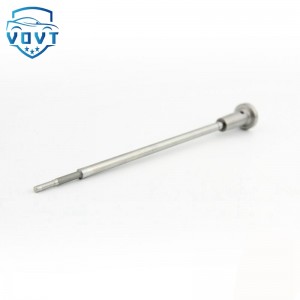High Precision New Diesel Injector Control Valve F00VC01045 Valve Assembly for Fuel Injector Engine Spare Parts
Products Description
| Reference Codes | F00VC01045 |
| Application | / |
| MOQ | 6 PCS |
| Certification | ISO9001 |
| Place of Origin | China |
| Packaging | Neutral packing |
| Quality Control | 100% tested before shipment |
| Lead time | 7~10 working days |
| Payment | T/T, L/C, Paypal, Western Union, MoneyGram or as your requirement |
How to test the performance of the injector control valve?
Appearance inspection
Check whether there is obvious damage, deformation, cracks or corrosion on the outside of the injector control valve, especially the valve body and connection parts.
Check whether the outer shell of the solenoid coil is burnt, discolored or other abnormalities. If so, it may indicate that the solenoid coil has been exposed to high temperature and there is a hidden danger of failure.
Confirm whether there are signs of carbon deposits, blockage or wear on the injector nozzle. These problems may affect the accuracy and effect of fuel injection.
Resistance measurement
Use the ohm range of the multimeter to connect the test leads to the two terminals of the injector control valve solenoid coil and measure its resistance value.
The resistance value of the injector control valve solenoid coil of different models is different, generally ranging from more than ten ohms to tens of ohms. Compare the measurement results with the standard values in the vehicle maintenance manual. If the resistance value deviates too much, it means that the solenoid coil may have short circuit, open circuit or inter-turn short circuit.
Fuel injection uniformity test
Install the injector on the injection test bench, which can provide stable fuel pressure and simulate the injection pulse signal of the engine.
Start the test bench, let the injector spray at a certain frequency and pulse width, and observe the uniformity of the injection. Under normal circumstances, the injector should spray a uniform and fine oil mist. If the injection is found to be uneven, such as some injection holes spray more oil, some injection holes spray less oil, or oil droplets appear, it means that the needle valve of the injector control valve is not opened consistently, and there may be problems such as needle valve stagnation and nozzle clogging.
Injection volume test
On the injection test bench, the performance of the injector is evaluated by measuring the injection volume of the injector within a certain period of time. The test bench will be equipped with a corresponding measuring cup or flow meter to accurately measure the injection volume.
According to the requirements of different engine working conditions, set different injection pulse widths and frequencies, and measure the injection volume separately. Compare the measurement results with the standard injection volume in the maintenance manual. If the injection volume exceeds the allowable error range, it means that the injection volume control of the injector control valve is inaccurate, which may be due to poor performance of the electromagnetic coil, loose sealing of the needle valve, or problems with the control circuit.
Sealing test
When testing the sealing of the injector control valve, install the injector on the test bench, first increase the fuel pressure to the specified value, then turn off the injection pulse signal, and observe the fuel leakage of the injector within a certain period of time.
Under normal circumstances, there should be no obvious fuel leakage when the injector is closed. If fuel is found to drip from the injector nozzle or other parts, it means that the sealing of the injector control valve is not good. It may be that there is wear between the needle valve and the valve seat, the seal is damaged, or the electromagnetic coil cannot completely close the needle valve.
Dynamic response test
Use professional engine diagnostic equipment, connect to the vehicle's electronic control unit (ECU), send different injection instructions through the diagnostic equipment, and observe the dynamic response of the injector control valve.
Check whether the injector control valve can be opened and closed quickly according to the instructions of the ECU, and whether the response time under different working conditions meets the standard. If the response time of the injector is too long or too short, it will affect the performance of the engine. It may be that the electromagnetic coil responds slowly, the needle valve moves poorly, or there is a delay in the control circuit.
Ultrasonic testing
For some injector control valves with complex internal structures or difficult to detect by conventional methods, ultrasonic testing technology can be used.
The injector is placed in the ultrasonic testing equipment. The ultrasonic waves emitted by the equipment can penetrate the valve body and other parts of the injector control valve. By analyzing the reflected ultrasonic signals, it is detected whether there are tiny cracks, defects or blockages inside. This method can detect some internal faults that cannot be observed by the naked eye and improve the accuracy of detection.























